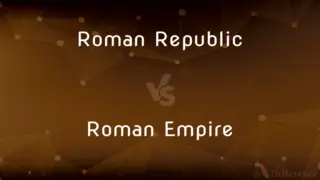Leading Power Factor vs. Lagging Power Factor — What's the Difference?
Edited by Tayyaba Rehman — By Fiza Rafique — Published on December 6, 2023
A Leading Power Factor occurs when current leads voltage in phase, typically with capacitive loads, while a Lagging Power Factor happens when current lags behind voltage, often with inductive loads.

Difference Between Leading Power Factor and Lagging Power Factor
Table of Contents
ADVERTISEMENT
Key Differences
A Leading Power Factor and a Lagging Power Factor represent different phase relationships between current and voltage in an AC circuit. The former indicates that current is leading voltage, while the latter suggests the opposite.
In a scenario with a Leading Power Factor, capacitive loads are often the primary contributors. Capacitors release stored energy, causing the current to peak before voltage. Conversely, with a Lagging Power Factor, it's inductive loads like motors or transformers that cause the current to peak after the voltage.
The importance of understanding both Leading Power Factor and Lagging Power Factor is paramount for efficient power system operation. An imbalance can cause unnecessary power loss and strain on equipment.
Corrections are often implemented in power systems to bring the power factor closer to unity. For a Leading Power Factor, inductors can be added, and for a Lagging Power Factor, capacitors might be introduced.
While both Leading Power Factor and Lagging Power Factor indicate a phase difference between current and voltage, their implications and causes differ. Proper management ensures optimized performance and longevity of electrical equipment.
ADVERTISEMENT
Comparison Chart
Phase Relationship
Current leads voltage.
Current lags behind voltage.
Typical Load Type
Capacitive loads.
Inductive loads.
Correction Device
Inductors.
Capacitors.
Energy Behavior
Releases stored energy.
Stores energy in magnetic fields.
Example Devices
Capacitors, some types of lighting.
Motors, transformers, coils.
Compare with Definitions
Leading Power Factor
Indicates capacitive nature of a circuit.
The presence of many capacitors resulted in a Leading Power Factor.
Lagging Power Factor
A factor often corrected using capacitors.
To mitigate the Lagging Power Factor, capacitors were added to the circuit.
Leading Power Factor
Current waveform peaks before voltage waveform.
The oscilloscope showed a Leading Power Factor in the AC circuit.
Lagging Power Factor
A condition causing current to rise post voltage.
Industrial areas often deal with a Lagging Power Factor due to many inductive devices.
Leading Power Factor
A factor that can be corrected using inductors.
To correct the Leading Power Factor, engineers added inductive loads.
Lagging Power Factor
Represents inductive nature of a circuit.
The transformer contributed to the Lagging Power Factor of the circuit.
Leading Power Factor
A phase condition with current ahead of voltage.
The circuit has a Leading Power Factor due to the capacitive load.
Lagging Power Factor
Current waveform peaks after voltage waveform.
The coil's characteristics resulted in a Lagging Power Factor.
Leading Power Factor
A condition causing voltage to rise after current.
The lighting system introduced a Leading Power Factor in the building's power system.
Lagging Power Factor
A phase scenario where current is behind voltage.
The motor-heavy system displayed a Lagging Power Factor.
Common Curiosities
What is a Leading Power Factor?
A Leading Power Factor occurs when current leads voltage, often due to capacitive loads.
What causes a Leading Power Factor?
A Leading Power Factor typically results from capacitive loads
How does a Lagging Power Factor manifest?
A Lagging Power Factor happens when current lags behind voltage, commonly with inductive loads.
Which devices might cause a Lagging Power Factor?
Inductive devices like motors and transformers can cause a Lagging Power Factor.
What's the corrective measure for a Lagging Power Factor?
Capacitors are often added to correct a Lagging Power Factor.
How can you correct a Leading Power Factor?
A Leading Power Factor can be corrected by introducing inductors.
Are these power factors good or bad?
Both Leading Power Factor and Lagging Power Factor can be detrimental if too far from unity; correction is desired for efficiency.
Can a system have both types of power factors?
A system can have areas or devices with Leading Power Factor and others with Lagging Power Factor, but an overall system will lean one way.
Why is it vital to understand these power factors?
Recognizing Leading Power Factor and Lagging Power Factor helps optimize power systems and protect equipment.
Do residential areas typically have a Leading Power Factor?
Residential areas might have a Leading Power Factor from certain lighting, but it's less pronounced than in specialized settings.
Can power factors impact my electricity bill?
Yes, utilities might charge penalties for significant deviations from unity, be it Leading Power Factor or Lagging Power Factor.
Which power factor is more common in industrial settings?
Industrial settings often see a Lagging Power Factor due to many motors and inductive devices.
Share Your Discovery

Previous Comparison
Microsoft Yammer vs. Facebook Workplace
Next Comparison
Roman Republic vs. Roman EmpireAuthor Spotlight
Written by
Fiza RafiqueFiza Rafique is a skilled content writer at AskDifference.com, where she meticulously refines and enhances written pieces. Drawing from her vast editorial expertise, Fiza ensures clarity, accuracy, and precision in every article. Passionate about language, she continually seeks to elevate the quality of content for readers worldwide.
Edited by
Tayyaba RehmanTayyaba Rehman is a distinguished writer, currently serving as a primary contributor to askdifference.com. As a researcher in semantics and etymology, Tayyaba's passion for the complexity of languages and their distinctions has found a perfect home on the platform. Tayyaba delves into the intricacies of language, distinguishing between commonly confused words and phrases, thereby providing clarity for readers worldwide.
















































